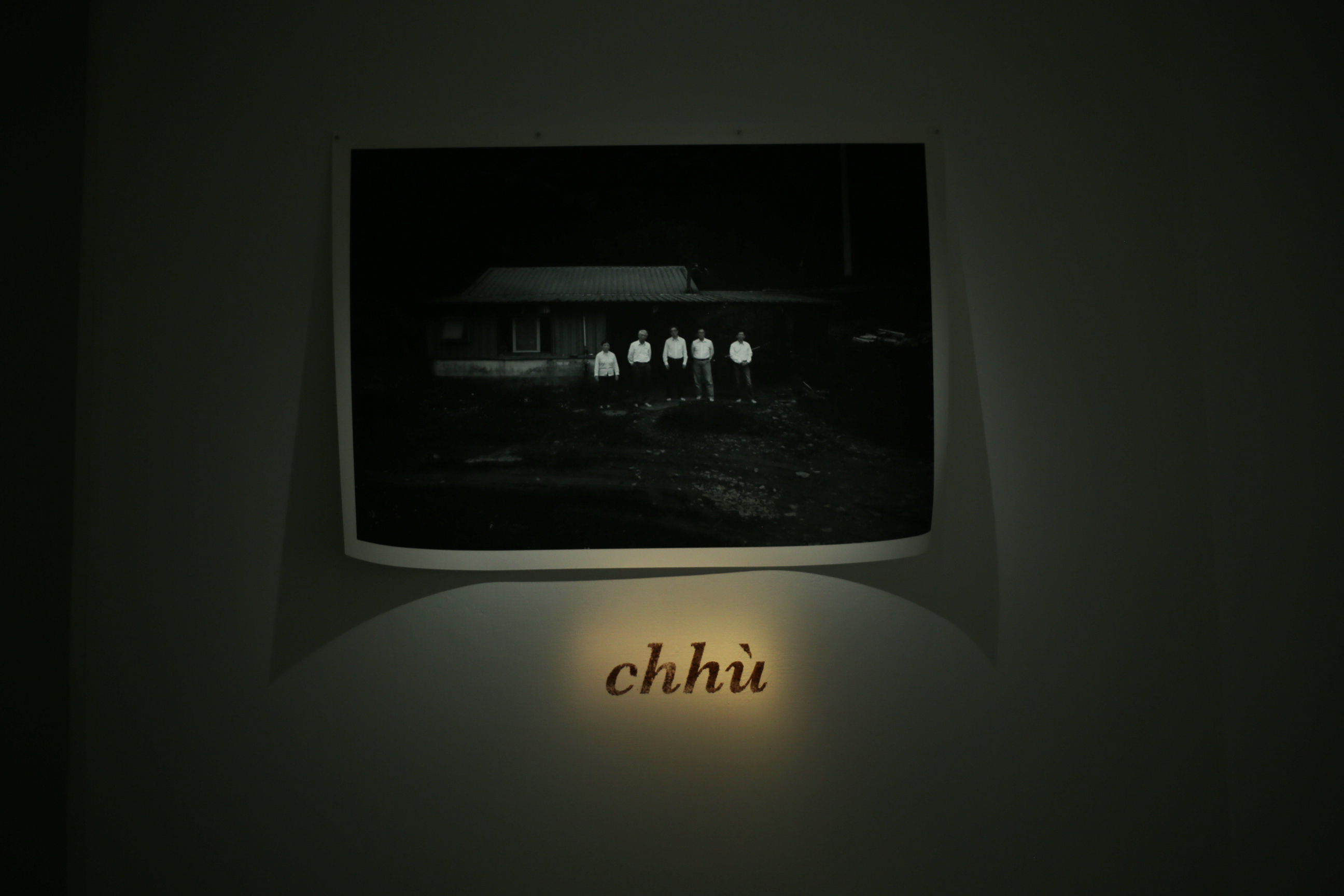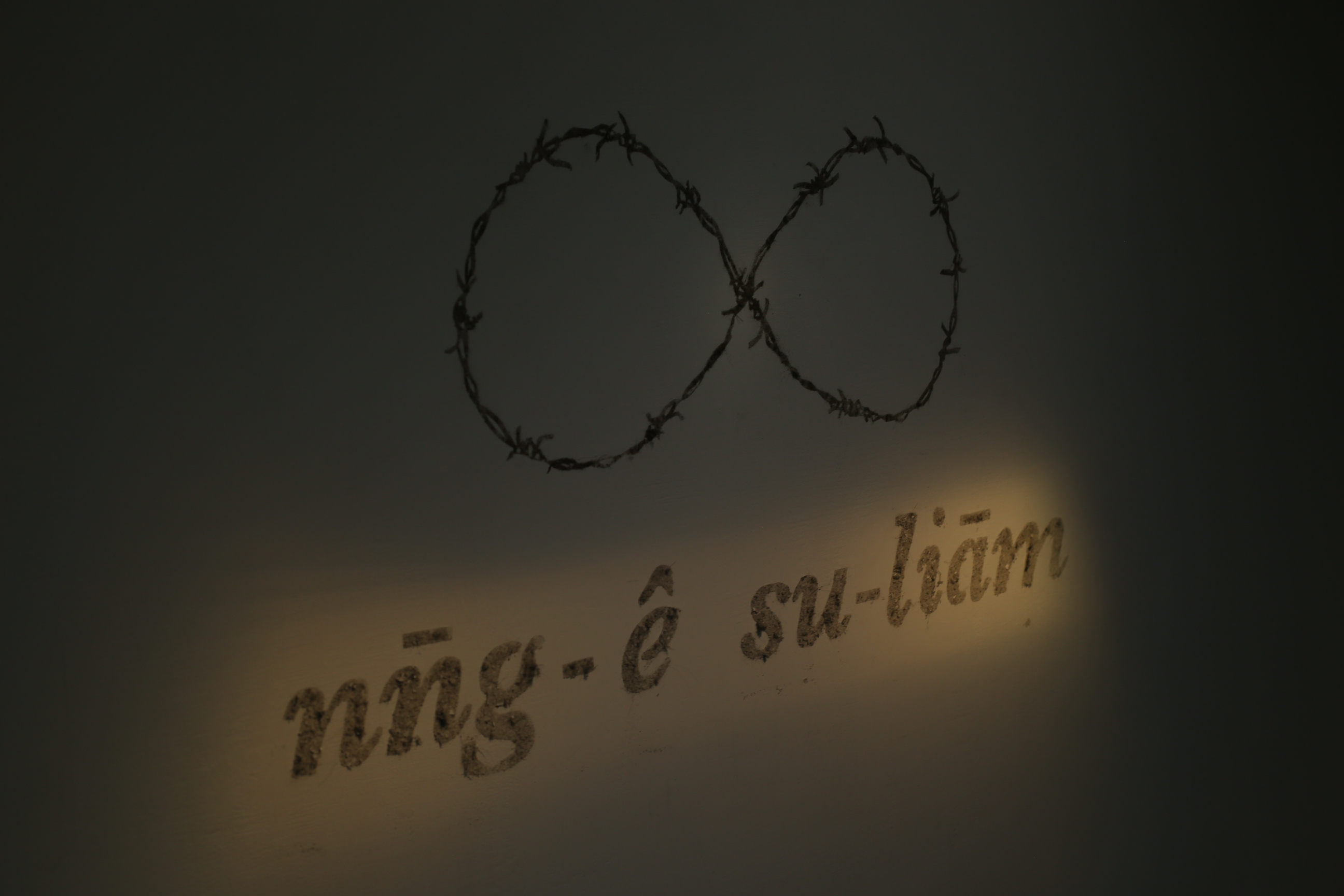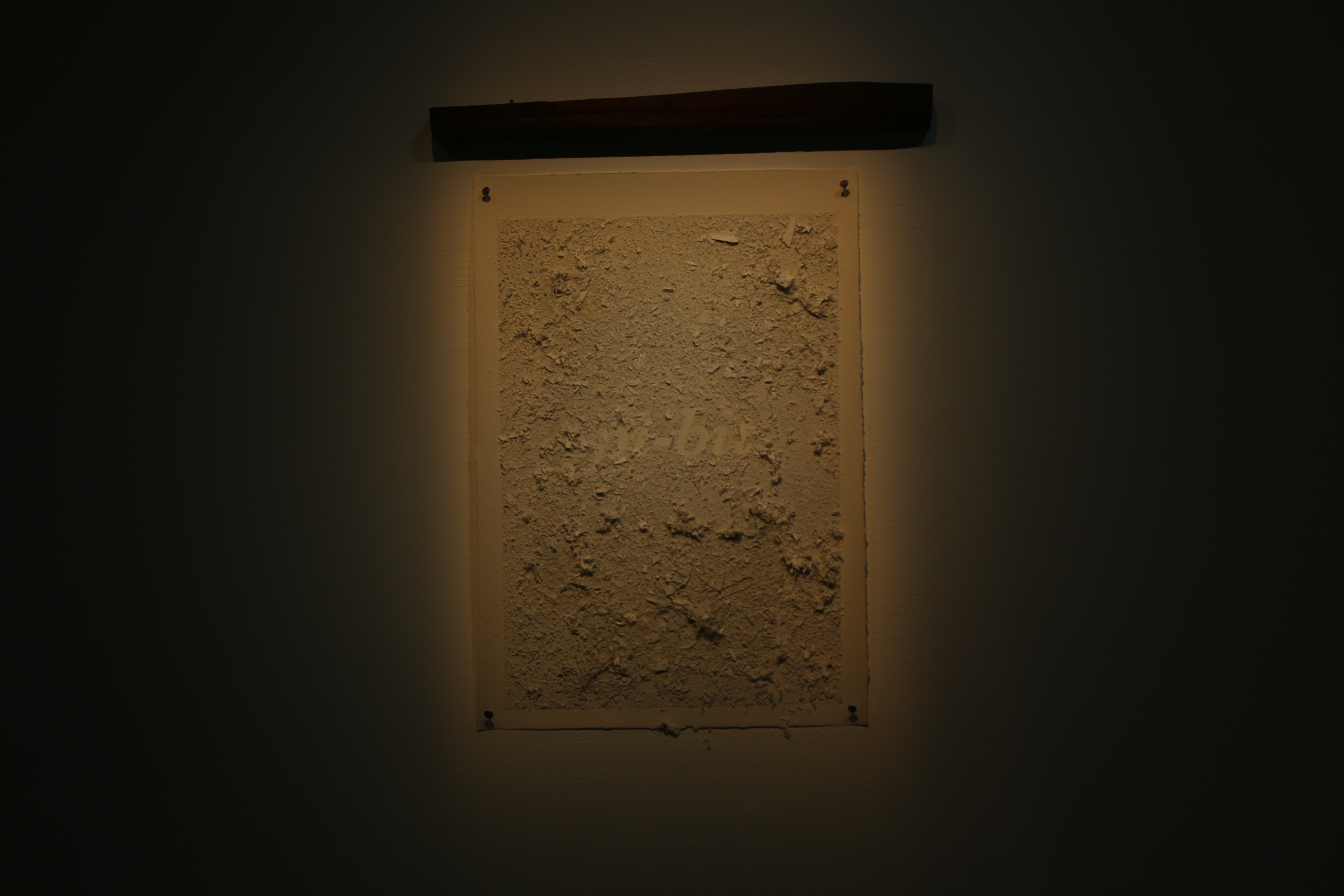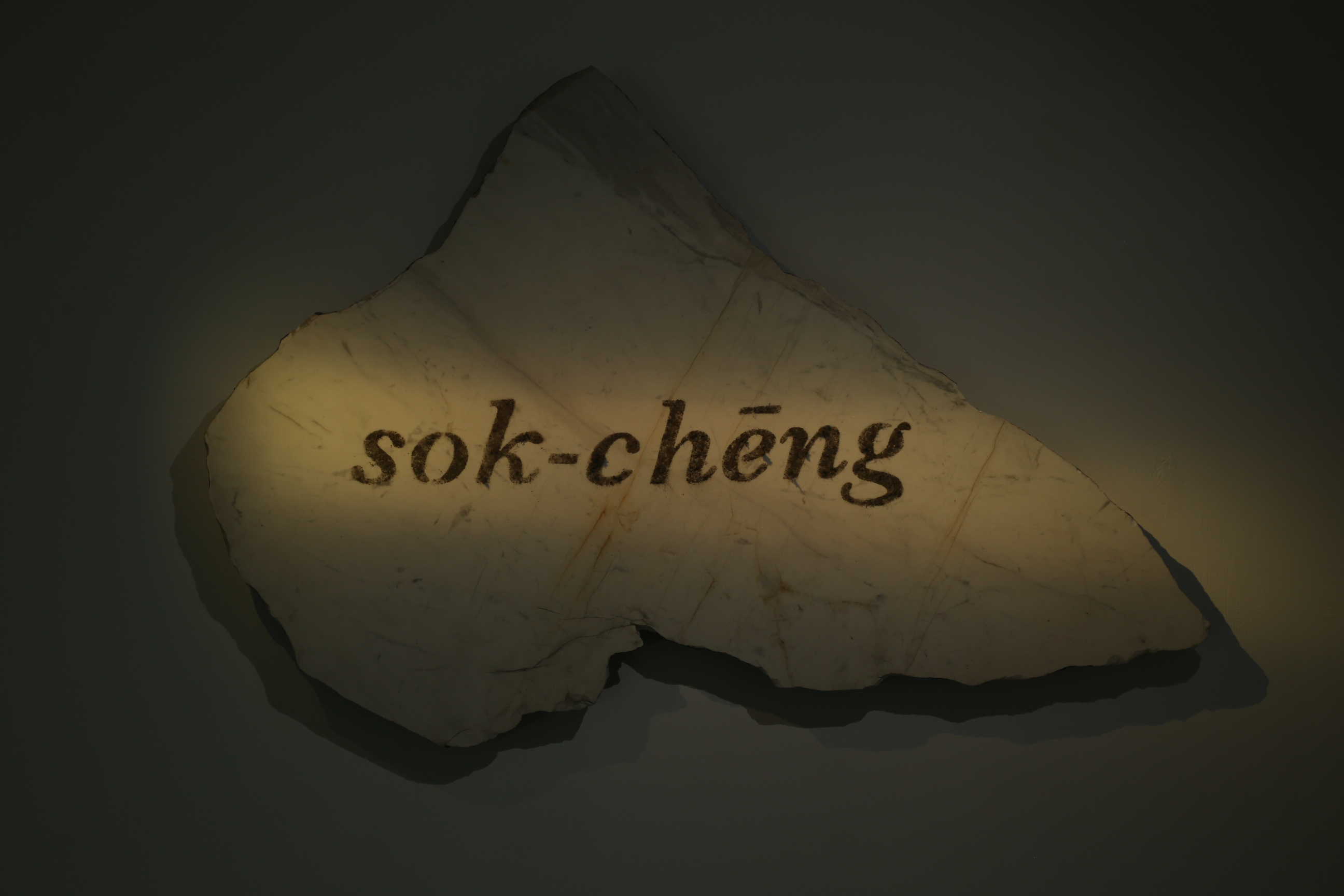《勇為》是王鼎曄家族史系列的第二部作品,這兩個字摘自阿公的一本手札。作品以自身的家族作為故事文本,在收集文本的過程中,邀請家族的長輩們加入LINE群組,請他們書寫片段回憶,重新建構了這個家族的集體記憶,開創新的共同話語,透過這個展覽,家人之間的關係也產生微妙的變化。
在作品與展覽呈現上,王鼎曄使用自己家中所打掃的塵土,在牆上顯現出台語拼音,塵土以微光朦朧的照著,觀者念著牆上字母的發音,塵土、微光、發音拼湊出幽幽的氛圍。在展場的最深處,是一部錄像作品,錄像文本是從LINE群組的記憶拼湊出,拼湊出阿公死亡前幾天所發生的事。面對死亡並不容易,透過勇氣,因而有了這個名為「勇為」的展覽,同時也讓藝術修復了自己與家族。
Confronting Memories is WANG Ding-Yeh’s second installment in the family history series. The two Chinese characters in the title have been taken from his grandfather’s journal. His own family provides the narrative text for the work. In the process of collecting the text, elderly family members were invited to join a Line group chat, and asked to write down memory fragments in a reconstruction of the family’s collective memory and open up new mutual conversation. Through this exhibition, relationships between family members also underwent subtle transformations.
In presenting the work and the exhibition, WANG Ding-Yeh uses dust gathered from cleaning his own home to reveal words in Taiwanese dialect spelled out phonetically on the wall. In the dim glow of faint light, viewers sound out the phonetics written in dust on the wall. The dust, faint light, and murmuring all amalgamate to create a ghostly atmosphere. At the furthest reaches of the exhibition space is a video work using text compiled from recollections made in the Line group chat which piece together events on the days leading up to his grandfather’s death. Confronting death is never easy, but through courage and this exhibition entitled “Confronting Memories”, the self and family experience healing through art.
王鼎曄 WANG Ding-Yeh
2011年獲得德國德勒斯登高等藝術學院—卓越藝術家文憑。擅長使用錄像裝置與繪畫,作品環繞於自身、社會與環境議題。深信透過創作能與外部社會連結或是對抗,並且同時能自我療癒。作品於台灣、美國、以色列、法國、德國、日本、韓國、馬來西亞等國展出。
WANG Ding-Yeh received his Meisterschule degree from the Dresden Academy of Fine Arts (Hochschule für Bildende Künste Dresden) in 2011. He is adept at using video installation and painting in his art to address issues concerning the self, society, and the environment. He believes that artistic creativity enables connections with, or resistance to the eternal society, while simultaneously healing the self. His work has been exhibited in Taiwan, the United States, Israel, France, Germany, Japan, Korea, and Malaysia.
王鼎曄
何仲昌、 張弼凱
林依璇、 余柏羲
林依璇、余柏羲、 鄧安庭
非常廟藝文空間
關鍵字
藝術家談作品
「塵土是一種意識上的鬼魅,它就存在於過去與現在的空間之中,也是關於家族記憶的歷史見證。」
2015年,藝術家王鼎曄受邀至檳城參加馬來西亞數位藝術節(DA+C),無意中從爸爸口中得知,原來奶奶就是在檳城出生,10歲時才回到中國。他對奶奶的生命經歷產生好奇,於是從家中長輩們口中一一拼湊出歷史片斷,他將這些片斷整理成文本,並以此為記憶地圖,趁著藝術節之便,實地走訪了一次「奶奶的檳城」,這即是王鼎曄「家族史系列」的開始……
從自身的家族記憶出發
《勇為》是家族史系列的第二部作品,這兩個字摘自爺爺的一本手札。然而,為什麼要以「勇為」命名?王鼎曄說,面對記憶,大家都需要勇氣。
原來,王鼎曄的爺爺(王元芳)是白色恐怖受難者,早在很久以前便過世,當時五個孩子都還年幼,對他的記憶本來就很模糊,又因時間的堆積讓記憶更加消逝。一開始收集創作文本時,王鼎曄先邀請長輩們建立一個Line群組,爸爸還將群組名稱取名為「記憶266」,因為266正是小時候居住的三星鄕郵遞區號。
大家在群組中開始書寫記憶,破碎的記憶被拼湊、堆疊,被修改、指正。接著,記憶又會被彼此的記憶召喚,穿插在記憶中還有情感與思念。就這樣,爺爺的些許生命歷程得以再次浮現,除了短暫的生命外,還鏡射了那個時代濃濃的歷史氣味,一段深白色的時代。
塵土是記憶的樣貌
不僅如此,王鼎曄也邀請長輩們回到三星的老房子一起打掃,並使用打掃的塵土創作了九件作品,每件作品皆以塵土舖陳,在牆上顯現教會羅馬拼音所拼出的台語文字。塵土以微光朦朧的照著,觀者念著牆上字母的發音,塵土、微光、發音拼湊出幽幽的氛圍。
「塵土是一種意識上的鬼魅,它就存在於過去與現在的空間之中,也是關於家族記憶的歷史見證。」王鼎曄說,記憶就像塵土,平日沈睡像是不存在,一旦被擾動之後,就會飛揚起來。
展場中的第一件作品《離開與消逝》,以紅土映襯的台語文字:「我會死兩次,一次是靈魂離開,再次是從你的記憶中消失。」重新建構了爺爺存在的狀態。《肅靜》則將灰塵置放在大理石板上,強烈展現了時代的氛圍狀態。《秘密》這件作品,就像爺爺的死,至今仍是一個秘密。而在《回去》這幅作品中寫著「如果可以回到過去,我會去找你」,其實正反映出王鼎曄渴慕爺爺的心情,透過展覽,爺爺的形象在他的心中重新被塑造了。
在展場的最深處,是一部錄像作品《勇為》,錄像文本是從Line群組的記憶而來,父親掃著地,塵土揚起又落下,象徵著記憶被擾動的狀態。所有人拼湊出爺爺死亡前幾天所發生的事,面對死亡並不容易,透過勇氣,因而有了這個名為《勇為》的展覽,同時也讓藝術修復了自己與家族。
以微歷史拼湊大歷史
家族史系列發展至今已經創作了三部作品,第四部正在進行中,還有家族故事文本的群眾參與計劃也同時進行中。王鼎曄藉由這樣的創作方式,相互增進或修復了家人之間的關係。
「爺爺過世了半世紀,成為不想被提起的一段記憶。過去叔叔伯伯分居各地,平時也沒機會再談起這件事,透過這個展覽,觸發了新的關係與感動,家族成員更常分享記憶與現在發生的事,也更常彼此問候。」
王鼎曄認為,歷史不應該只是教科書裡的歷史,透過常民生活所呈現出來的才是歷史。他從回到家族開始,重新建構「家」的關係與概念,當它一點一點被拼湊出來,就能自然形成那個時代的氛圍,此時同樣的生命經驗就會被召喚,開啟記憶的再次對話,屬於每個人的小小微歷史,便能凝聚成大歷史了。
評審談作品
在展覽空間中卻如碑文般,創造出永恆感。
入圍理由
延續探詢大時代裡的家族故事,創作者以更為精練的語彙,創造出極具溫度和詩意的展現。在故事重建過程中,那未明的、不可言說、無法述說的,以充滿弦外之音的方式,把影像所不能及的時空給牽引出來。展覽應用極為簡單的元素:以家中打掃的塵土來書寫,以白話字(閩南語羅馬拼音文字)揭露語言的政治,搭配黃色光暈、大理石、圖案以及照片、影像,陌生的、疏離的、聲音的、話語的,看似灰飛煙滅、短暫的,在展覽空間中卻如碑文般,創造出永恆感。(主筆/吳瑪悧)
Comments on the finalist artworks
Continuing the exploration of a family story within the grand historical context, the artist used more refined vocabularies to create this highly heartwarming and poetic presentation. In the process of reconstructing the story, all the ambiguous, indescribable and unspeakable things as well as the time and space that cannot be expressed through images were represented by means of subtle implications. The exhibition made use of a rather simple element: writings made with dust collected from house-cleaning. The colloquial words (Romanized, phonetical spellings of Taiwanese) exposed the politics of language, and were matched with marble stones, images, photographs and videos in a setting permeated with a yellow glow. The strange, the unfamiliar, the audio, the verbal, all of which seemed to be transient and ephemeral, contrarily created a sense of permanence that was reminiscent of monumental inscriptions in the exhibition. (Commentator: WU Mali)








